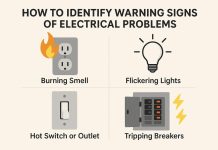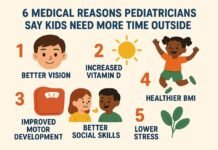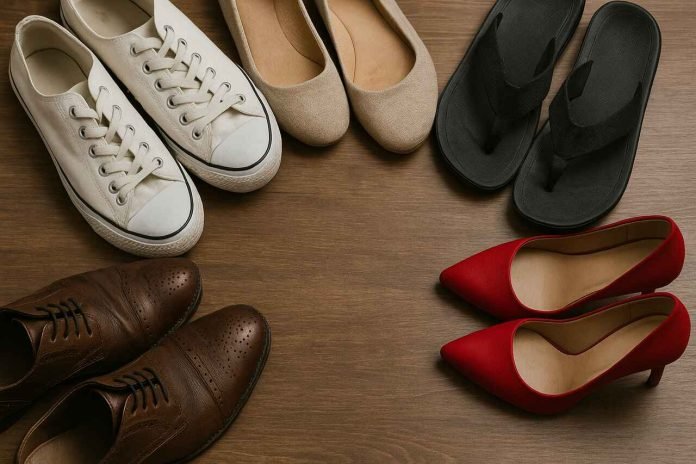Most people don’t think twice about the shoes they wear each day. You grab what looks good, what matches your outfit, or what feels familiar. But your footwear choices could be quietly affecting your body in ways you may not realise. The wrong fit or style doesn’t just hurt your feet, it can lead to a ripple effect of problems that impact your knees, hips, back, and posture.
Here are seven common footwear mistakes that could be doing more harm than you think.
1. Not Wearing Wide Fitting Shoes
Shoes that are too narrow are one of the most overlooked culprits behind foot pain and long-term damage. If your toes are constantly squeezed together or your feet feel cramped, that’s a red flag.
Wearing narrow shoes over time can lead to issues like:
- Bunions
- Hammertoes
- Nerve compression
- Blisters and corns
- Deformed toe alignment
Your feet naturally spread as you walk. Narrow shoes fight against this motion and force your foot into an unnatural shape. This doesn’t just cause surface discomfort, it changes how you walk. That altered movement pattern can then stress your ankles, knees, and even your lower back.
If your feet feel cramped by mid-morning or if your pinky toe always ends up squashed, your shoes are likely too narrow. Wide fitting shoes give your feet room to move, flex, and support your body properly.
2. Prioritising Style Over Function
Footwear trends come and go. Pointed toes, ultra-flat soles, sky-high heels – they all look stylish but often ignore what your feet actually need. Shoes should provide stability, cushioning, and support for the natural arches of your foot. Most fashion-forward footwear doesn’t tick any of those boxes.
Wearing style-focused shoes occasionally is fine. But making them your go-to pair every day? That’s where the damage begins. Over time, poor support can lead to collapsed arches, plantar fasciitis, and alignment problems that affect your gait and cause persistent pain.
When choosing shoes, function should come first. Look for shape, structure, and fit. If they also look good, that’s a bonus.
3. Wearing Shoes With No Arch Support
Your foot’s arch is designed to absorb shock and distribute your weight evenly. When you wear shoes with flat soles or worn-out insoles, the arch gets no support and ends up collapsing. This puts more pressure on your heels, toes, and knees.
Lack of arch support is especially problematic if you spend a lot of time walking or standing. Even short bursts in unsupportive shoes can lead to sore feet, joint strain, and tension in your lower back.
If you often feel foot fatigue or heel pain by the end of the day, poor arch support could be to blame. Your shoes should gently lift and support the arch, helping your feet do their job without overworking them.
4. Keeping Old, Worn-Out Shoes
Shoes have a shelf life, even if they still look fine on the outside. Over time, the inner sole and cushioning wear down. That means your feet aren’t getting the shock absorption and support they once did.
If you keep wearing shoes that are past their best, the materials no longer protect your joints or encourage proper foot alignment. This can lead to problems like shin splints, ankle pain, and even lower back tightness.
As a general rule, everyday shoes should be replaced every 12 to 18 months. If you’re on your feet a lot, it could be even sooner. Watch for signs like uneven soles, worn tread, or flattened insoles. Those small details are your body’s early warning system.
5. Using One Type of Shoe for Everything
Different activities need different types of support. If you wear the same pair of shoes for walking, working, exercising, and going out, you’re likely short-changing your feet in some situations.
For example, running shoes are made to absorb repeated impact, while walking shoes are designed for heel-to-toe motion. A casual pair might be fine for short errands but won’t hold up during a long day of standing. Wearing one type for everything means your feet are often in the wrong gear, so to speak.
It’s worth having a small selection of shoes tailored for different purposes. Your feet will thank you in the long run.
6. Ignoring Foot Pain or Discomfort
Pain is a message. If your feet hurt during or after wearing certain shoes, that’s your body telling you something isn’t right. Don’t ignore it or assume you just need to “break them in.” That discomfort usually means your footwear doesn’t fit well, isn’t supporting your foot properly, or is placing pressure in the wrong areas.
Chronic foot pain isn’t just annoying, it’s a sign of underlying stress on your joints, muscles, or tendons. The longer you ignore it, the more likely it is to lead to secondary issues in your knees, hips, and spine.
Pay attention to how your feet feel after wearing different shoes. If something always leaves you sore or stiff, stop wearing it. No style is worth injury.
7. Walking Around Barefoot or in Thin Slippers for Long Periods
At home, many people prefer to go barefoot or wear soft slippers. While this feels comfortable, it often leaves your feet without any support at all. Hard floors like wood, tile, or laminate don’t absorb shock the way carpet might. That means your feet, knees, and back are taking the impact every time you walk across the room.
Thin-soled slippers or walking barefoot for long periods can cause:
- Heel pain
- Arch strain
- Tight calves and Achilles tendons
- Poor posture from lack of support
If you’re spending hours standing or walking at home, it’s worth using supportive indoor shoes or structured slippers with good soles and cushioning. Your joints will feel the difference almost immediately.
Rethink What You Put on Your Feet
Footwear is one of the most overlooked aspects of health and comfort. It’s not just about avoiding pain, it’s about how your entire body functions throughout the day. When your shoes don’t fit well or fail to support you, it starts a chain reaction that affects more than just your feet.
Take a moment to check your shoes. Do they really fit the shape of your foot? Do they give you proper arch support? Are they still in good condition? Small changes to what you wear on your feet can lead to big improvements in how you move, stand, and feel.
Better shoes aren’t about trends or price tags. They’re about giving your body what it needs to stay balanced, strong, and pain-free. Your future knees and back will be grateful you made the change.










